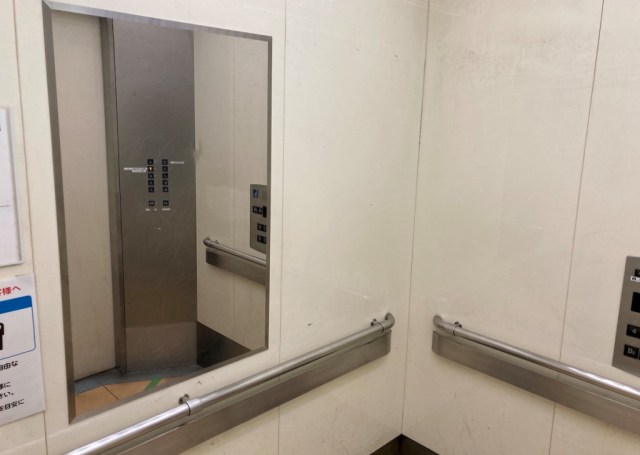
There’s an important reason, and no, it’s not so you can see how good you look.
Our Japanese-language reporter Masanuki Sunakoma is a curious guy. We’re not saying he’s weird (though a certain amount of personal peculiarity is practically prerequisite for members of the SoraNews24 team), but rather that he’s a deep thinker who wants to learn more about the world around him when he spots an opportunity to do so.
So the last time he hopped in an elevator, he found himself wondering “How come there’s a mirror in here?”
While you won’t find a mirror in each and every elevator in Japan, they’re very common equipment…but why? Maybe it’s to let people examine their hair or clothes, Masanuki thought, so that they can make sure they’re looking their best for an important business meeting or admire their freshly styled pompadour.
But what about elevators that have that smaller mirror mounted in a corner of the elevator’s ceiling? Is that some kind of crime-prevention measure, so that you can keep an eye out for pickpockets, gropers, or literal backstabbers?
Thankfully, there’s an authoritative source for the answer to Masanuki’s mirror question: the Japan Elevator Association. We were actually a little surprised to learn such an organization exists, but we suppose it makes sense, since you’d ideally like there to be some sort of governing body certifying that the metal box you’re hanging in half a dozen stories above the ground has been installed safely.
And apparently Masanuki isn’t the only one to wonder about the mirrors, as the Japan Elevator Association explains the reason for them in its website FAQ, stating:
“Mirrors are installed in elevators for the benefit of passengers using wheelchairs, who might not be able to rotate the chair after boarding and will need to exit the elevator while facing backwards.”
Yep, it turns out that the real reason for the mirrors is to help wheelchair users. Even if there’s room enough to wheel the chair in, there might not be enough empty space around it to spin a 180 when the passenger wants to get off. Having a mirror, though, allows the wheelchair user to move straight backwards through the door, then turn around once they’re in a more spacious area.
Sure enough, after learning this Masanuki noticed that in the building where he took the above photo, the handicapped call button summons the elevator on the left…
…and that elevator has a mirror, while the one on the right doesn’t.
Of course, people in wheelchairs aren’t duty-bound to use the handicapped elevator call button. Japanese law now requires government buildings to have mirrors in all elevators, and some local municipalities have their own similar regulations for certain types of buildings.
So sure, feel free to check yourself out in the mirror next time you’re inside an elevator, but keep an eye out that you’re not blocking the view for someone who needs to consult it before they get off, since it turns out those reflective surfaces, like those bumps on the sidewalk in Japan, have a very important purpose.
Source: Japan Elevator Association
Photos ©SoraNews24
● Want to hear about SoraNews24’s latest articles as soon as they’re published? Follow us on Facebook and Twitter!
[ Read in Japanese ]

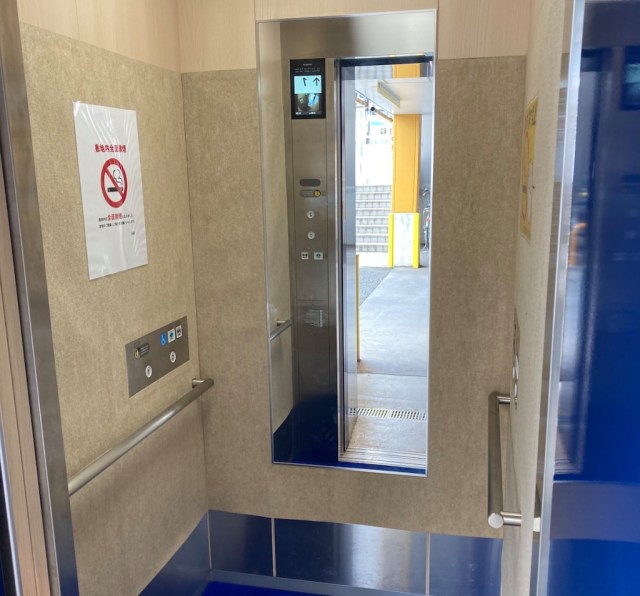
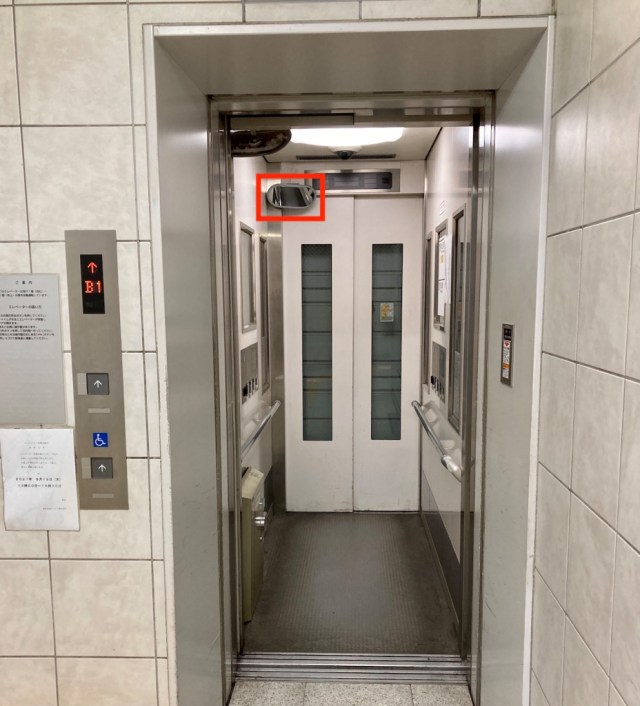
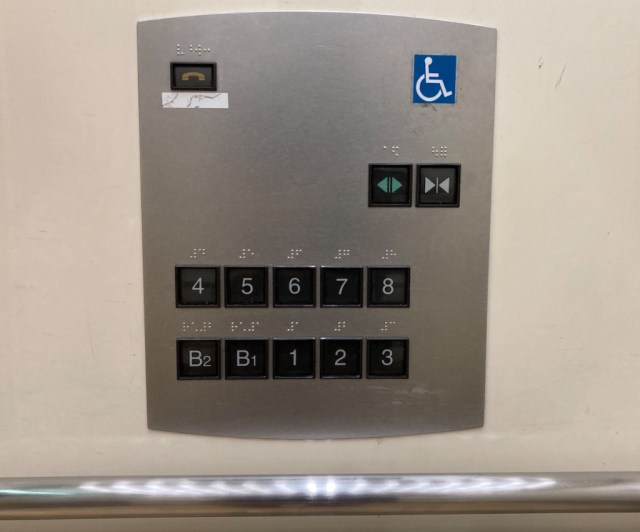
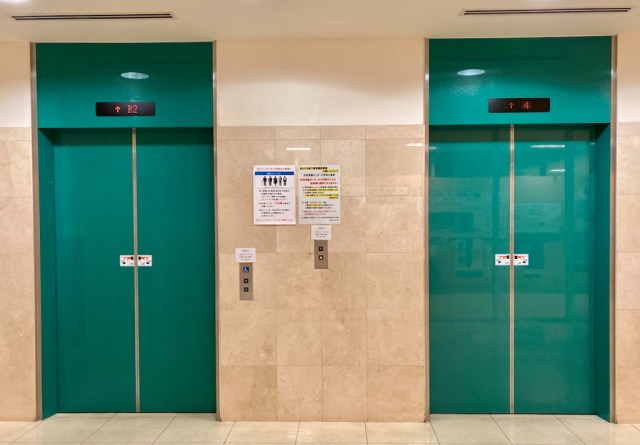
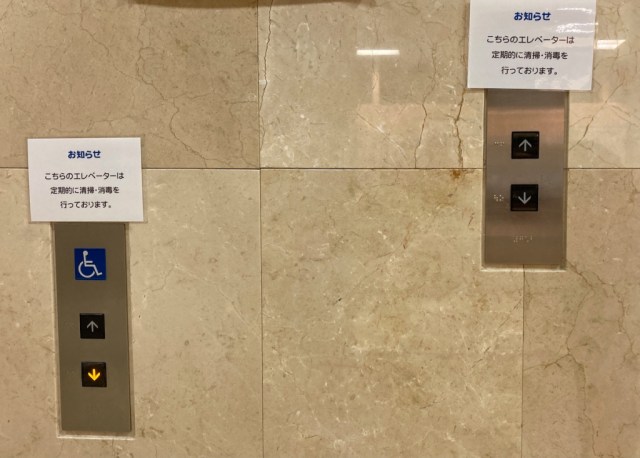
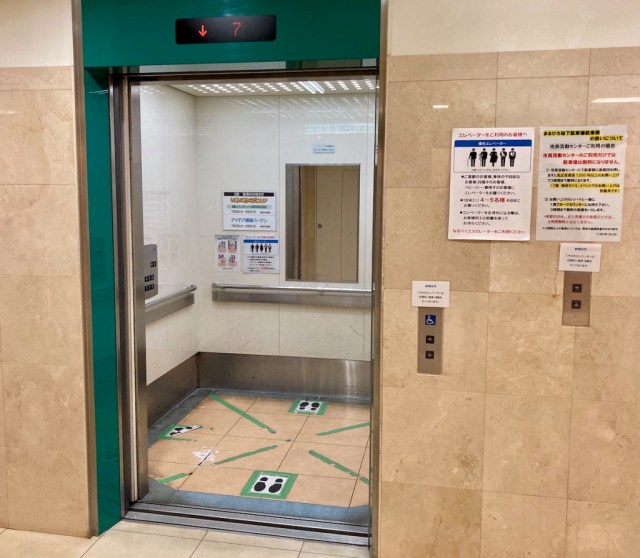
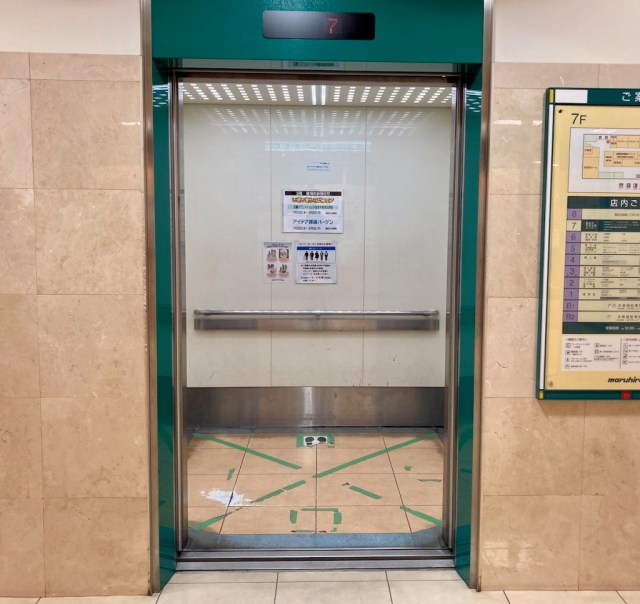
 What’s it like traversing Tokyo using only wheelchair accessible routes?
What’s it like traversing Tokyo using only wheelchair accessible routes? Ginza is a fancy place…just look at the elevators!
Ginza is a fancy place…just look at the elevators! How to cancel a floor on a Japanese elevator
How to cancel a floor on a Japanese elevator What should you do if you get stuck in an elevator in an earthquake? Japan’s NHK offers five tips
What should you do if you get stuck in an elevator in an earthquake? Japan’s NHK offers five tips Impatient Chinese man’s decision to jump kick elevator door is a surprisingly poor one 【Video】
Impatient Chinese man’s decision to jump kick elevator door is a surprisingly poor one 【Video】 Foreigner’s request for help in Tokyo makes us sad for the state of society
Foreigner’s request for help in Tokyo makes us sad for the state of society Japanese city loses residents’ personal data, which was on paper being transported on a windy day
Japanese city loses residents’ personal data, which was on paper being transported on a windy day Should you add tartar sauce to Japanese curry rice? CoCo Ichi makes diners an unusual offer
Should you add tartar sauce to Japanese curry rice? CoCo Ichi makes diners an unusual offer Seaside scenery, history, and so many desserts on Yokohama’s Akai Kutsu【Japan Loop Buses】
Seaside scenery, history, and so many desserts on Yokohama’s Akai Kutsu【Japan Loop Buses】 Ghibli Park now selling “Grilled Frogs” from food cart in Valley of Witches
Ghibli Park now selling “Grilled Frogs” from food cart in Valley of Witches Harajuku Station’s beautiful old wooden building is set to return, with a new complex around it
Harajuku Station’s beautiful old wooden building is set to return, with a new complex around it Japanese breast size study shows rapid growth in previously smallest-busted region of county
Japanese breast size study shows rapid growth in previously smallest-busted region of county Is Starbucks Japan’s new Gohobi Melon Frappuccino really the ultimate melon Frappuccino?
Is Starbucks Japan’s new Gohobi Melon Frappuccino really the ultimate melon Frappuccino? Historical figures get manga makeovers from artists of Spy x Family, My Hero Academia and more
Historical figures get manga makeovers from artists of Spy x Family, My Hero Academia and more McDonald’s new Happy Meals offer up cute and practical Sanrio lifestyle goods
McDonald’s new Happy Meals offer up cute and practical Sanrio lifestyle goods Japanese ramen restaurants under pressure from new yen banknotes
Japanese ramen restaurants under pressure from new yen banknotes French Fries Bread in Tokyo’s Shibuya becomes a hit on social media
French Fries Bread in Tokyo’s Shibuya becomes a hit on social media Studio Ghibli releases new action figures featuring Nausicaä of the Valley of the Wind characters
Studio Ghibli releases new action figures featuring Nausicaä of the Valley of the Wind characters New private rooms on Tokaido Shinkansen change the way we travel from Tokyo to Kyoto
New private rooms on Tokaido Shinkansen change the way we travel from Tokyo to Kyoto Red light district sushi restaurant in Tokyo shows us just how wrong we were about it
Red light district sushi restaurant in Tokyo shows us just how wrong we were about it Tokyo Tsukiji fish market site to be redeveloped with 50,000-seat stadium, hotel, shopping center
Tokyo Tsukiji fish market site to be redeveloped with 50,000-seat stadium, hotel, shopping center All-you-can-drink Starbucks and amazing views part of Tokyo’s new 170 meter-high sky lounge
All-you-can-drink Starbucks and amazing views part of Tokyo’s new 170 meter-high sky lounge Beautiful Ghibli sealing wax kits let you create accessories and elegant letter decorations【Pics】
Beautiful Ghibli sealing wax kits let you create accessories and elegant letter decorations【Pics】 Studio Ghibli releases Kiki’s Delivery Service chocolate cake pouches in Japan
Studio Ghibli releases Kiki’s Delivery Service chocolate cake pouches in Japan New definition of “Japanese whiskey” goes into effect to prevent fakes from fooling overseas buyers
New definition of “Japanese whiskey” goes into effect to prevent fakes from fooling overseas buyers Our Japanese reporter visits Costco in the U.S., finds super American and very Japanese things
Our Japanese reporter visits Costco in the U.S., finds super American and very Japanese things Studio Ghibli unveils Mother’s Day gift set that captures the love in My Neighbour Totoro
Studio Ghibli unveils Mother’s Day gift set that captures the love in My Neighbour Totoro More foreign tourists than ever before in history visited Japan last month
More foreign tourists than ever before in history visited Japan last month New Pokémon cakes let you eat your way through Pikachu and all the Eevee evolutions
New Pokémon cakes let you eat your way through Pikachu and all the Eevee evolutions Sales of Japan’s most convenient train ticket/shopping payment cards suspended indefinitely
Sales of Japan’s most convenient train ticket/shopping payment cards suspended indefinitely Sold-out Studio Ghibli desktop humidifiers are back so Totoro can help you through the dry season
Sold-out Studio Ghibli desktop humidifiers are back so Totoro can help you through the dry season Japanese government to make first change to romanization spelling rules since the 1950s
Japanese government to make first change to romanization spelling rules since the 1950s Ghibli founders Toshio Suzuki and Hayao Miyazaki contribute to Japanese whisky Totoro label design
Ghibli founders Toshio Suzuki and Hayao Miyazaki contribute to Japanese whisky Totoro label design Doraemon found buried at sea as scene from 1993 anime becomes real life【Photos】
Doraemon found buried at sea as scene from 1993 anime becomes real life【Photos】 Tokyo’s most famous Starbucks is closed
Tokyo’s most famous Starbucks is closed One Piece characters’ nationalities revealed, but fans have mixed opinions
One Piece characters’ nationalities revealed, but fans have mixed opinions We asked a Uniqlo employee what four things we should buy and their suggestions didn’t disappoint
We asked a Uniqlo employee what four things we should buy and their suggestions didn’t disappoint Princesses, fruits, and blacksmiths: Study reveals the 30 most unusual family names in Japan
Princesses, fruits, and blacksmiths: Study reveals the 30 most unusual family names in Japan What happens if you drop your keys into an elevator shaft gap? Kyoto company explains【Video】
What happens if you drop your keys into an elevator shaft gap? Kyoto company explains【Video】 This little-known spot is a haven for train otaku, with a view of both Mt. Fuji and bullet trains
This little-known spot is a haven for train otaku, with a view of both Mt. Fuji and bullet trains A piece of Japanese business manners that many Japanese people could do without
A piece of Japanese business manners that many Japanese people could do without What’s the real reason for the ‘floating’ 3-D signs at Haneda Airport?
What’s the real reason for the ‘floating’ 3-D signs at Haneda Airport? Heading off the beaten path in Hokkaido for a beautiful view and local sweets
Heading off the beaten path in Hokkaido for a beautiful view and local sweets The strongest peeing boy statue in Japan is a hidden gem of sightseeing in Saitama
The strongest peeing boy statue in Japan is a hidden gem of sightseeing in Saitama Chinese boy unleashes torrent of pee on elevator control panel, regrets immediately【Video】
Chinese boy unleashes torrent of pee on elevator control panel, regrets immediately【Video】 Backlash as Japanese police tweet warns women to not ride elevators alone with men
Backlash as Japanese police tweet warns women to not ride elevators alone with men We order an amazing Vegeta battle armor suit and dash down the street to celebrate Saiyan Day
We order an amazing Vegeta battle armor suit and dash down the street to celebrate Saiyan Day These ambiguous objects create such mind-blowing optical illusions, we almost believe it’s magic
These ambiguous objects create such mind-blowing optical illusions, we almost believe it’s magic European and American Men’s Wig: the lowest-rated wig on Amazon Japan
European and American Men’s Wig: the lowest-rated wig on Amazon Japan We eat a meal to remember…at a Japanese police station in Fukuoka
We eat a meal to remember…at a Japanese police station in Fukuoka Stay at a Japanese capsule hotel in Tokyo for less than US$20 a night
Stay at a Japanese capsule hotel in Tokyo for less than US$20 a night We eat an intimidating curry with toppings randomly chosen for us by CoCo Ichibanya’s ‘Gacha’ app
We eat an intimidating curry with toppings randomly chosen for us by CoCo Ichibanya’s ‘Gacha’ app Shrine in Japan issues “beautiful woman certificates,” so we went to get one【Photos】
Shrine in Japan issues “beautiful woman certificates,” so we went to get one【Photos】
Leave a Reply